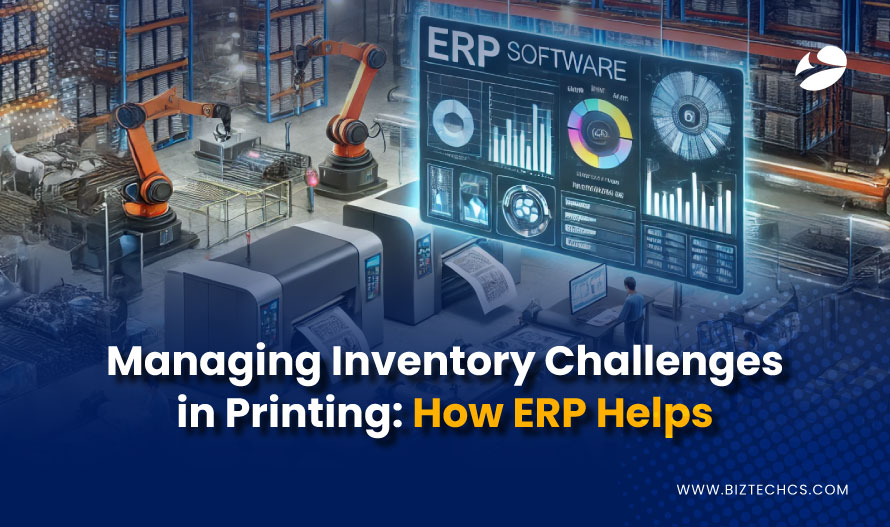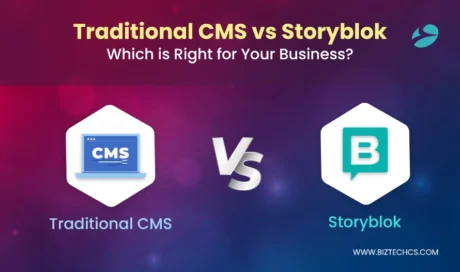472
Managing Inventory Challenges in Printing: How ERP Helps
14 Feb, 2025
10 min read
472
14 Feb, 2025
10 min read
Table Of Content

Managing inventory in the printing sector presents unique challenges, from tracking raw materials to ensuring timely order fulfillment.
Companies often experience production delays, increased operational costs, and stock discrepancies without a systematic approach. ERP for printing industry solutions is crucial in streamlining inventory management by providing real-time visibility and automation to prevent shortages and overstock issues.
Additionally, ERP enhances quality control by monitoring raw materials and finished products, ensuring consistency and compliance. An ERP system reduces costs by optimizing resource allocation, ultimately helping businesses improve efficiency and profitability.
This blog post will explore how ERP can help printing companies overcome inventory challenges and create a more organized and effective operation.
A consistent supply of paper, ink, toner, and custom substrates is essential for printing companies.
Production can be delayed by shortages brought on by supply chain interruptions, price fluctuations, and erratic demand. Businesses may find obtaining products at the appropriate time and price difficult if inventory management is not done correctly.
ERP software implementation helps reduce risks by optimizing procurement and tracking stock levels.
For printing companies, maintaining the proper inventory balance is essential. Overstocking raises storage expenses and the possibility of material waste, particularly for perishable materials like ink and coatings.
However, understocking can cause production plans to be disrupted, which can result in missed deadlines and unhappy customers.
By matching stock levels with business requirements, demand forecasting helps to avoid these problems.
Some printing supplies, such as specialist inks and coatings, have a short shelf life and can lose their usefulness if not used immediately.
Additionally, outdated supplies and equipment may become obsolete due to printing technology and ERP software developments.
Businesses risk losing money because of out-of-date or expired inventory if inventory is not properly tracked.
Investing in effective inventory management guarantees a higher return on investment and improved resource utilization.
Seasonal fluctuations, changes in the market, and erratic customer demands all contribute to the printing industry’s shifting demand.
Profitability may be impacted by either surplus inventory or supply shortages brought on by inaccurate demand predictions. Without precise data, companies risk understocking necessary supplies or overbuying slow-moving commodities.
Utilizing ERP software for data-driven planning increases productivity and optimizes ROI.
A cloud-based inventory management tool called Zoho Inventory was created to assist small and medium-sized enterprises manage their goods more efficiently.
Businesses can handle multi-channel sales from a single location thanks to its easy integration with eCommerce platforms like Shopify and Amazon.
To cut down on manual labor, the software automates crucial procedures, including order fulfillment, stock tracking, and reordering.
Businesses may increase productivity and maintain precise stock levels using Zoho Inventory’s automated tools and user-friendly interface.
A complete enterprise resource planning solution, NetSuite ERP offers sophisticated demand planning and inventory tracking. It helps companies to streamline supply chain management by automating warehouse operations and stock restocking.
Businesses can minimize expenses and avoid stock shortages by optimizing inventory levels with the use of real-time data visibility.
Designed for large businesses with complex inventory needs, NetSuite ERP offers scalable solutions to manage high-volume transactions efficiently.
Cin7 is an intelligent order and inventory management system designed for companies with many sales channels.
It provides a centralized stock, sales, and fulfillment management solution by integrating with eCommerce, wholesale, and retail systems.
The system is perfect for companies that sell in both online and offline markets since it has integrated point-of-sale (POS) and business-to-business eCommerce features.
Businesses may improve order accuracy and minimize errors by using Cin7’s automation features to track inventories in real-time.
PrintXpand is an inventory management system for companies in the print sector that maximizes order processing and stock control.
It facilitates the effective management of order workflows, completed goods, and raw resources, guaranteeing smooth manufacturing.
Businesses may monitor stock levels, check inventory movement, and avoid supply shortages by utilizing automation solutions.
PrintXpand is tailored for companies that need specialized inventory management to handle custom printing jobs and bulk orders with precision.
The primary objective of Just-In-Time (JIT) inventory management is to lower holding costs by placing orders for inventory only when necessary. Through the prevention of surplus inventory, this strategy reduces waste and enhances cash flow.
However, in order to guarantee on-time delivery, precise demand forecasts and solid supplier connections are needed.
By effectively allocating resources, ERP software helps many firms increase return on investment and streamline JIT operations.
Businesses can use Economic Order Quantity (EOQ) to figure out the ideal order size that will reduce overall inventory expenses. To maintain effective stock levels, it strikes a balance between ordering and holding expenses.
For EOQ to be implemented, precise demand forecasting and ERP software integration are necessary for automated computations.
By cutting down on surplus inventory and operating expenses, this method increases return on investment.
ABC analysis divides inventory into three groups according to quantity and value to enhance inventory management.
High-value items (A) require strict control, moderate-value items (B) need balanced oversight, and low-value items (C) demand minimal supervision.
ERP software is used by businesses to track and manage these areas effectively. By concentrating resources on essential inventory and improving stock control, this approach raises return on investment.
Dropshipping enables suppliers to ship goods straight to consumers, saving companies the trouble of keeping inventory on hand. This improves cash flow and overall efficiency by lowering handling and storage expenses.
However, success hinges on trustworthy suppliers and precise demand forecasting to sustain client pleasure.
Integrating ERP software in dropshipping operations enhances inventory management and ensures a better return on investment through streamlined order processing.
In the printing sector, inventory management presents many difficulties, yet the correct ERP software can have a big impact. With features like automatic demand forecasting and real-time tracking, ERP systems assist companies in cutting waste, preventing stock problems, and streamlining processes. This results in increased customer happiness, reduced expenses, and higher efficiency.
As productivity rises and inventory errors fall, the return on investment becomes more evident. Printing companies can enhance their scalability and profitability by taking charge of their inventory management through ERP software.
Investing in ERP software development ensures that businesses get tailored solutions that align with their specific needs, further optimizing operations. Long-term success in a field where accuracy and productivity are crucial is ensured by making the proper tool investments now.
The printing industry faces challenges like managing a wide variety of paper types, inks, and other raw materials with different shelf lives. Stockouts and overstocking are common due to unpredictable demand, leading to increased costs and waste.
Yes, ERP improves customer satisfaction by ensuring timely order fulfillment through accurate inventory tracking and automated reordering. It also enhances transparency by providing real-time updates on order status, reducing delays and miscommunication.
Implementing ERP reduces waste by preventing over-purchasing and spoilage of printing materials. It also lowers labor costs by automating stock monitoring and order processing, reducing manual errors and inefficiencies.
The ROI of ERP in printing comes from reduced material waste, improved order accuracy, and fewer rush orders, leading to cost savings. Over time, better inventory control increases profitability by ensuring smoother operations and customer retention.

Storyblok
24826
By Devik Gondaliya
02 Apr, 2025

Storyblok
25770
By Devik Gondaliya
01 Apr, 2025

Storyblok
26450
By Devik Gondaliya
27 Mar, 2025